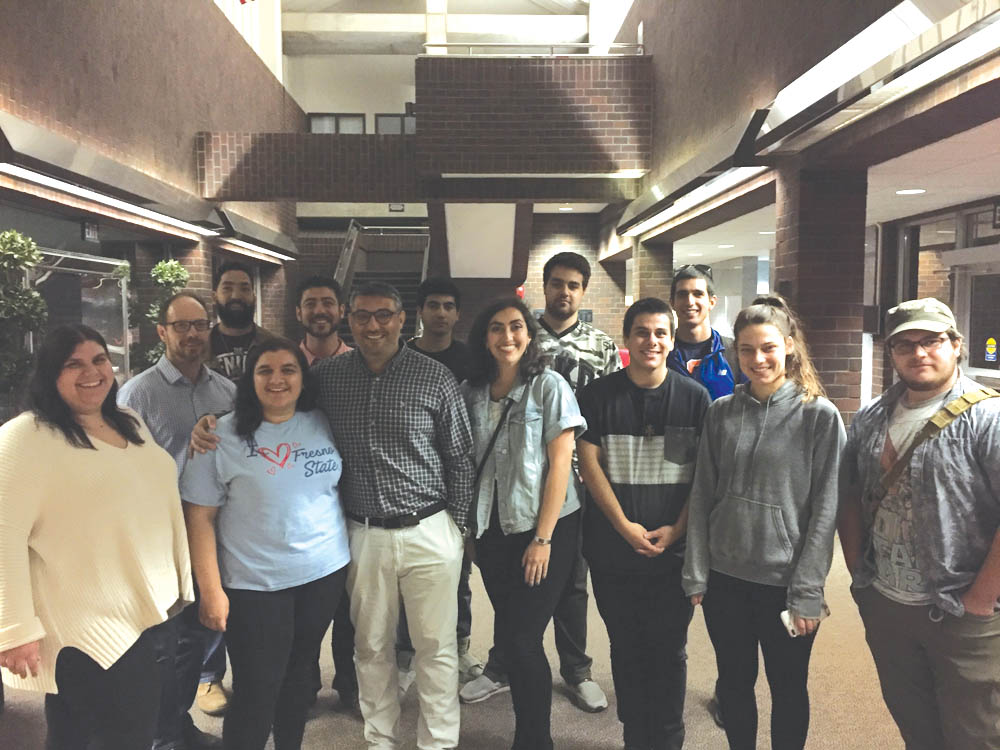
Photo: Christine Pambukyan
Staff Report
The July 23, 1908 Revolution in the Ottoman Empire was a significant moment in the history of the Empire. There was great hope that the reinstatement of the 1876 Constitution would guarantee equal rights among all of the citizens of the Empire, including the Armenians. The new ruling party, the Committee of Union and Progress, represented these early hopes, but over the course of the succeeding seven years, hopes for fundamental changes were progressively dashed. Ultimately the Armenians of the Ottoman Empire would be subjected to a Genocide.
History often addresses the role of great figures or great events, but often it is individuals, whose decisions shape the course of events. On Tuesday, November 6, Dr. Ümit Kurt presented one such example in his lecture entitled, “The Curious Case of Ahmed Necmeddin Bey: A Look into the Sociopolitical Climate in Aintab on the Eve of 1915.” This was Dr. Kurt’s final lecture in a three-part series of lectures as the Kazan Visiting Professor in Armenian Studies for Fall 2018.
Dr. Kurt’s research focuses on the city of Aintab, which held a significant Armenian population on the eve of World War I. Dr. Kurt, using a micro-historical approach, studies the role and agency that individuals had in the Armenian Genocide. Thus, his talks offered new insight by studying the periphery of the Empire.
How the Ottoman Constitution was perceived by Armenians, Turks, Arabs, Jews, and Greeks represented the central thesis in Dr. Kurt’s talk. He explained about how ordinary citizens reacted towards the Constitution, ultimately dividing the people of Aintab into two groups—those in favor of the new Constitution and those firmly opposed.
The story of Ahmed Necmeddin Bey is central to this story as he ultimately was posted to the area of Salamiyya in Syria during the 1915 deportations and massacres of Armenians. Contrary to what might have been expected from an Ottoman official, Necmeddin Bey actually played a benevolent role in the period by saving many of the Armenians of Aintab from annihilation.
The historiography of the Armenian Genocide has often been told only through foreign sources, whether through Ottoman Turkish archives or through European archives, therefore neglecting the agency provided by Armenian sources. Sometimes these sources in Armenian are the only ones that touch upon important events. In his lecture, Dr. Kurt presented his arguments using as a source the diaries of two men, Krikor Bogharian and Fr. Nerses Tavukjian, both from Aintab and both of whom survived the initial deportations of Armenians. Their diaries shed light on the motivations of Necmeddin Bey and explain some of his actions.
Necmeddin Bey began his political career as kaimakam (district governor) of the area of Aintab. Because of his diligence as kaimakam, he was looked upon as a reputable and honorable man by both Armenians and Turks. Appointed during the reign of Abdul Hamid II, Necmeddin Bey was opposed to the Revolution and refused to follow the orders of the CUP. A group of CUP agitators then surrounded his house in Aintab and beat him, and even threatened him with death. Necmeddin Bey escaped and later was transferred to Syria. He continued in political service, even though he was a dedicated autocrat from the Abdul Hamid period.
Necmeddin Bey was able to hold onto power because the CUP did not have its own bureaucratic and administrative cadres. Even after the revival of the Constitution, many bureaucrats throughout the Empire were still loyal to Abdul Hamid II’s regime. Although, the CUP attempted to purge the bureaucratic ranks they were not able to discharge everyone because they lacked their own cadres to fill these posts.
Necmeddin Bey was appointed as kaimakan of Salamiyya in 1915, and his efforts to improve living conditions for Armenians there and in particular his attempts to save Aintab’s prominent Armenian families still holds a place in the memory of Aintab’s Armenians. The diaries of Bogharian and Fr. Nerses both refer to Ahmed Necmeddin Bey’s deeds in saving the Armenians. “If we would like to judge history justly, we should not forget Necmeddin Bey’s deeds and his virtuous acts; we should give him his due.… Necmeddin Bey helped save a few thousand Armenians and a majority of them were from Aintab,” wrote Bogharian.
Dr. Kurt concluded the lecture by noting that although Necmeddin Bey saved many Armenians, it may not have been for entirely altruistic reasons. Those Armenians saved were most often artisans and craftsmen, who were useful in the construction projects organized by Necmeddin Bey. But ultimately his decisions led to the survival of some of Aintab’s Armenian population.
Dr. Kurt presented a nuanced interpretation of a man who held a position of power within the Ottoman bureaucracy, and who had many options, but chose to exercise that power to aid the Armenians.
 Hye Sharzhoom Armenian Action
Hye Sharzhoom Armenian Action